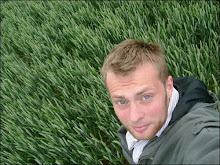You can find the first part of this feature here: http://booksadventures.blogspot.com/2010/10/patricia-wrightson-part-1-song-of.html
Patricia Wrightson’s Shadows of Time (1994) is a strange and powerful novel. It recounts the journey of an Aboriginal boy and English colonist girl who, by the gift of spirits, ‘travel in a timeless dimension’ – drifting without ageing or changing through Australian history. En route they are chased as devils, encounter various supernatural creatures and even come across a mysterious stone figure who may be the protagonist of the earlier Wirrun books. Although Wrightson had to some extent ‘let go’ of indigenous subject matter by this period, Shadows unmistakeably revisits some of the themes of her earlier novels.
Mark Macleod links Shadows to the Australian bicentenary of 1988. ‘That itself was a problematic anniversary. Indigenous Australians had already renamed Australia Day (26 January, the day when Captain Phillip took possession of the country in the name of the English king) 'Survival Day'. And as the Bicentenary approached non-Indigenous Australians were increasingly asking 'What is there to celebrate?'
The timeless quality of the children’s journey in Shadows, ‘given the privileges of water – to flow wherever is natural’, allows for a meditation on Australian history and, thereby, on Wrightson’s concept of culture.
As Mark Macleod explained in our recent interview:
‘In Shadows of Time, Wrightson invents a spirit character that seems very like those she borrowed from Indigenous culture in earlier works, but is in fact her own. For a writer who speaks repeatedly of borrowing only the equivalent of European 'fairies' and being careful not to touch the spirits of creation mythology, and who speaks of her terror of misrepresenting the spirits she does borrow, this is almost a defiant move, coming as it does after she has acknowledged that time has overtaken her whole project. The novel is therefore a coda to her major work, reasserting the mutability of cultures and her right as an artist to let her imagination flow where it will. Her readers and Wrightson herself might have changed their views over time - but not entirely.’
As time continues to flow, and Wrightson becomes a posthumous figure to be considered primarily through her legacy, there are challenges ahead for those who wish to preserve her work and circulate it for a new generation.
Mark Macleod comments, ‘I think we are still vaguely embarrassed or guilty about the idea that she might have been just another one in a long line of exploiters of Indigenous people.’
But it is precisely the encounter with Wrightson’s texts which dispels that idea, while at the same time forcing us to consider the complex and uncomfortable connections between storytelling and the legacy of colonialism.
A fantasy writer ‘cannot restore the original context for mythic stories, but she can create new contexts – as living cultures themselves do constantly. The fantasist can use all the resources available to the contemporary novelist to fill gaps within and around the story, and at the same time can alert the reader to some of what was lost.' - Brian AtteberyBrian Attebery makes a distinction between a fantasy writer like Wrightson and any self-appointed white spokesperson for Aboriginal people: ‘Her job, as a writer, is to work out in fictional form her own relationship with Australia’s troubled history and haunted landscape. Her strategy has been to bring in Wirrun and other characters to share the task, going where she cannot go. These fictional collaborators remind readers that we need to invite other collaborators, fictional and real, to help us extend the quest for understanding beyond the boundaries of the text itself.’
Attebery’s comments raise so many questions worthy of debate. That fantasy writer ‘alerting the reader to some of what was lost’ sounds like those white 1930s poets busy writing on behalf of the Aboriginal culture they perceived to be dying, which leads us back to asking: Who set Wrightson the task of ‘working out in fictional form her own relationship with Australia’s troubled history and haunted landscape’? And what do we make of the notion of a ‘fictional collaborator’?
These are questions to which there’s no final answer, but they are thrown up by the challenge of Patricia Wrightson’s legacy today – which forms the basis of our final instalment, next time on Books and Adventures.
You can go to the fifth and final part of this feature by clicking here.

No comments:
Post a Comment